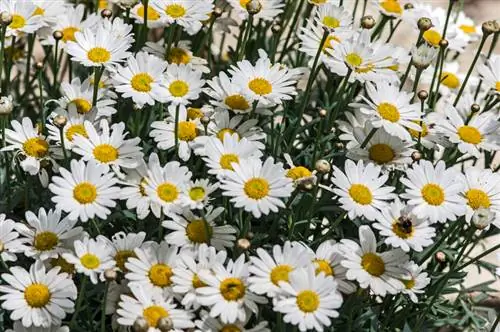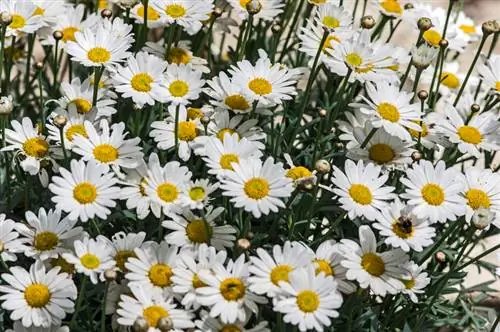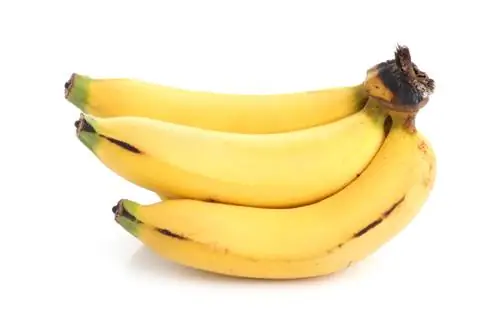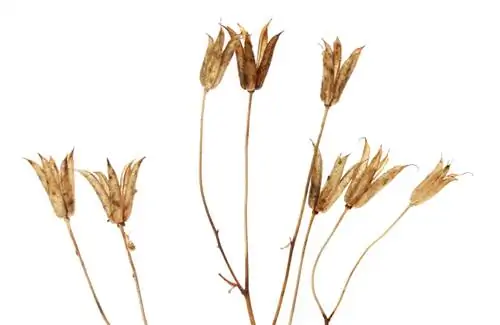- Author admin [email protected].
- Public 2023-12-25 17:45.
- Last modified 2025-01-23 11:20.
The daisy smiles cheekily at us with its yellow eye from a wreath of bright white ray flowers. Well known from the idyllic cottage garden, the historic perennial has lost none of its relevance. Whether as a lavishly flowering solitaire or a decorative companion in the magnificent perennial bed - the magical Leucanthemum adorns all sunny locations with flying colors. The following answers to frequently asked questions summarize all the details surrounding successful cultivation.

What is the best way to care for daisies?
Daisies are easy-care perennials that thrive in full sun and prefer fresh, moist, well-drained soil. They need moderate watering, regular cutting for re-blooming, compost fertilization in the bed and liquid fertilizer in the pot. They are overwintered with autumn leaf protection or in a frost-free indoor area.
Planting daisies correctly
Planting in spring increases the chances of a he althy winter. Between the end of April and the beginning of June, the soil in the sunny location is meticulously weeded and loosened. Please remove roots, stones and other soil contaminants that stand in the way of vital rooting. The addition of compost or bark humus stimulates the soil organisms and ensures the supply of nutrients. It is beneficial to soak the potted root balls in water. Then plant the now potted young plants so deep that the ball of soil is just below the surface. Last but not least, water on the day of planting and regularly afterwards to stimulate growth.
Care tips
After planting, an adequate water supply ensures the start of a he althy perennial life. In the further course, the following care program meets the modest requirements of your daisy:
- Water moderately but regularly without causing waterlogging
- In April and after the first pruning, fertilize the bed with compost
- Fertilize daisy in the pot liquidly every 2-3 weeks from April until the end of the flowering period
- After the first flowering, cut back to a few centimeters to make room for the next flowering
In autumn, cut the bed daisies close to the ground and cover the root ball with autumn leaves and needle twigs. Potted flowers move to a bright, frost-free winter quarters.read more
Which location is suitable?
Their longing for every ray of sunshine is so great that the daisy gracefully turns its flower heads towards our mother star. Make life easy for your favorite perennial and give it a location in full sun. Towering hybrids also gratefully accept a position sheltered from the wind.read more
What soil does the plant need?
Its status as one of the most popular flowers for the country house garden is not least due to its undemanding nature when it comes to suitable soil conditions. The daisy thrives in any normal garden soil that has a fresh, moist to moderately dry structure. As long as waterlogging is frowned upon at the location, it feels right at home in the humus-rich, loose, permeable soil. The autumn daisy (Leucanthemella serotina) is more tolerant of moist soil than the drought-loving summer daisy (Leucanthemum maximum).
What is the best time to plant?
In terms of the ideal planting time, the daisy is out of the ordinary compared to other perennials. All the flowering beauties of this genus cope much better with planting in spring than in autumn. So put the young plants in the ground between the end of April and the beginning of June so that they are firmly rooted by winter.
When is flowering time?
Thanks to a diverse range of species and varieties, the white-yellow flower stars accompany us throughout the gardening year. We have put together the most popular species and their flowering times for you here:
- Meadow daisy (Leucanthemum vulgare): blooms from May to June, with a second bloom in September
- Summer daisy (Leucanthemum maximum): flowering period from July to August
- October daisy (Leucanthemella serotina): flowering period from September to October
The native ostrich daisy (Tanacetum corymbosum) is botanically assigned to a different species of daisy, but it hardly differs visually from meadow and summer daisies. This robust perennial boasts an extra long flowering period from June to August.read more
Cut daisy correctly
Pruning the perennial to just a few centimeters results in wasteful re-blooming. In addition, you make an important contribution to maintaining vitality. Last but not least, you prevent the growth of seed heads, which regularly comes at the expense of the abundance of flowers. In autumn, cut the plant back close to the ground if self-sowing is not planned. Otherwise, prune in late winter so that the withered plant parts can be used as additional winter protection.read more
Watering daisies
If there is no rain for a long period of time, pour the daisy directly onto the root disk. Short-term drought does not affect growth or abundance of flowers. However, the root ball should not dry out. Potted flowers, on the other hand, require regular watering as the substrate dries out more quickly.
Fertilize daisies properly
As a bedding perennial, fertilize daisies with compost in April for a dynamic start to the gardening season. We also recommend adding more nutrients after the first pruning to ensure rich re-blooming. Only rake in the organic fertilizer lightly and water again. If the flowers thrive in a bucket or balcony box, giving phosphorus-rich liquid fertilizer for 14 days has proven to be effective. From April until the species-specific end of the flowering period, add the preparation to the irrigation water.
Wintering
With a little gardening attention, your daisy will get through the winter safely. Cut the perennial back to the ground in autumn and then spread a layer of leaves over the root disc. To prevent the leaves from flying away, place a few pine fronds or brushwood on top. Please move potted plants to a bright, frost-free winter quarters. The unheated stairwell, the cool bedroom or the cold house are well suited. Continue to water the plants so that the root ball does not dry out. Please gradually accustom your winter guests to higher temperatures and sunlight in spring so that they don't experience culture shock.
Propagate daisies
If a daisy with bright flower stars has won your heart, the desire for more specimens is obvious. You can now save yourself the trouble of buying young plants because you can choose from the following, uncomplicated propagation methods:
- Dividing the root ball in spring
- Separating runners to allow them to root in the pot
- Cut cuttings with a length of 8-10 cm, place in lean substrate and keep constantly moist
These three variants of vegetative propagation provide you with young plants with exactly the same attributes as the mother plant. However, if you collect the seeds in autumn and sow them on the windowsill in March, you may be surprised by the results. Alternatively, use certified seeds from specialist retailers.
How do I transplant correctly?
Regular transplanting goes hand in hand with rejuvenating your daisy. Every 2-3 years it is time to pick up the perennial, divide it and replant it. A well-chosen date is spring, when the ground has completely thawed. Dig up the root ball and place it on a stable surface. Using a sharp knife or spade, divide the plant into several segments, each of which has at least two buds. In the new place previously enriched with compost, place the sections in the soil while maintaining the previous planting depth and water.
Marguerite in a pot
In pot culture, the daisy proves to be a little more maintenance-intensive than its counterparts in the bed. This is primarily due to the limited substrate volume and the exposed position in sunlight. Use a high-quality compost-based potting mix that is made more permeable using perlite, sand or lava granules. A water-bearing layer of pottery shards or grit over the floor opening is essential. On warm summer days, please check daily with a thumb test whether the soil has dried out so that you can water in good time. From April to September, 14-day applications of liquid fertilizer ensure the nutrient supply. Regular cleaning or bold pruning after the first flowering period will bring out lush subsequent blooms. A potted daisy prefers to spend the winter in bright, frost-free winter quarters.
Is daisy poisonous?
The daisy was primarily found in the cottage gardens of our ancestors because all parts of the plant are suitable for consumption. There is therefore no trace of toxic content anywhere. In fact, raw food fans eat the tender leaves as a salad in spring, snack on the flowers in summer and enjoy the roots as a substitute for turnips.read more
Yellow leaves
With yellow leaves, your daisy signals that it is not feeling well. As a rule, location problems and neglect in maintenance cause this damage. We have compiled the most common triggers with tips for solving problems for you here:
- Lack of light: move to a sunny location
- Drought stress: Never let the root ball dry out; Immerse the potted root ball in water once
- Sudden change of location: After wintering, gradually get used to summer conditions
- Waterlogging with root rot: transplanting and watering less
Mostly it is daisies in planters that suffer from yellow leaves. When grown in pots, the nutrient requirements are often underestimated; they are higher here than in beds. If you administer a liquid fertilizer (€14.00 on Amazon) for flowering plants every 2 weeks from April until the end of the flowering period, the plant will recover.read more
Beautiful varieties
- May Queen: Richly blooming meadow daisy for the natural country house garden; Growth height 70-75 cm
- Group pride: Stable summer daisy that enriches cottage gardens, containers and herbaceous beds; Growth height 60 cm
- Christine Hagemann: Lushly filled premium variety, the ideal cut flower thanks to its upright posture; Growth height 40-80 cm
- Snehurka: Noble, large-flowered Leucanthemum that delights with richly double flowers; Growth height 60-80 cm
- Silver Princess: Distinctive dwarf summer daisy that sets magical accents as a bed border; Growth height 30-40 cm
- Autumn Star: Majestic, late-blooming noble variety that causes a sensation as a fence-peeper; Growth height 120-140 cm
- Goldfinch: Exceptional variety that catches the eye with golden yellow, double flowers from June onwards; Growth height 60-80 cm
- Bouquet daisy: Robust wild perennial that adorns the natural border of the trees with rich branches; Growth height 60-80 cm
- Robinsons Rosa: Magnificent hybrid of the bouquet daisy with delicate pink flowers from May to July; Growth height 20-40 cm






